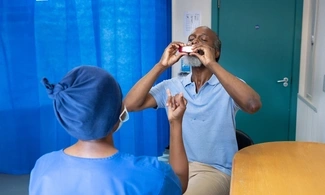Writing lay summaries
Lay summaries are descriptions of your work written in plain English. These are important as they explain your research to people outside of your field of expertise.
This includes lay members of our Research Review Panel who help to decide which project applications are awarded funding.
A good lay summary will include:
- Lay title
- Brief background or context to your research, including a description of the unmet need(s) that your research will address
- The aim of your project
- How you’ll do your research
- The impact of your project – what might your results mean for people with lung conditions?
Our grant application form asks for these points to be condensed into three sections; lay title, study focus, and summary of potential impact.
Language
Your writing should be simple and direct. Keep sentences short and to the point. Avoid technical or scientific terms (where possible, where not define them in simple language). Don’t use acronyms or jargon and try not to use normalisations – ‘utilisation’ could be better written as ‘using’. Essentially, try to write as you would speak.
Writing scientific summaries
Your research proposal and your project's scientific abstract are two key components of your grant application. Here’s some guidance for completing this section of your application.
Abstract
An abstract is a concise summary of all major aspects of your project. It should include:
- Brief background or context to your research
- Hypotheses or specific aims
- Methodology summary
- Expected results
- The impact of your project – how will your expected results contribute to your field of research?
We ask that abstracts are 300 words maximum.
Detailed description of research proposal
This is where you should describe what your project sets out to achieve, how it will achieve it, and the impact it will have on your field of research, and therefore, on people with lung conditions.
You should include an overview of your field of research and clearly explain how your project will contribute to it. Any gaps in evidence should be summarised and linked to how these led to the development of your project. Provide experimental design and methods (including power calculations where relevant), a statistical analysis plan where applicable, an outline timetable for the work. Supporting pilot data and references can also be included. Approach writing this section so that it can be understood in isolation or without referring to other parts of your application.
You’ll also need to include a project time frame, including proposed start and end date, in your grant application. Check the application guidance for page limits for the detailed research proposal.
Reflecting patient population in clinical studies
We know that a range of demographic factors like age, ethnicity and sex can affect the experience of, and outcomes in, lung conditions. For example, we know that women experience worse asthma symptoms than men. With this in mind, we ask applicants to consider demographics in their studies.
For example, for clinical studies we ask applicants to provide details of how they will ensure that the recruited population reflects the patient population in the UK for this area of interest. We would encourage researchers to analyse data by sex to help identify differences between males and females.
For animal studies, we ask applicants to describe the sex of animals that will be used in experiments, and justify the approach taken on this.







